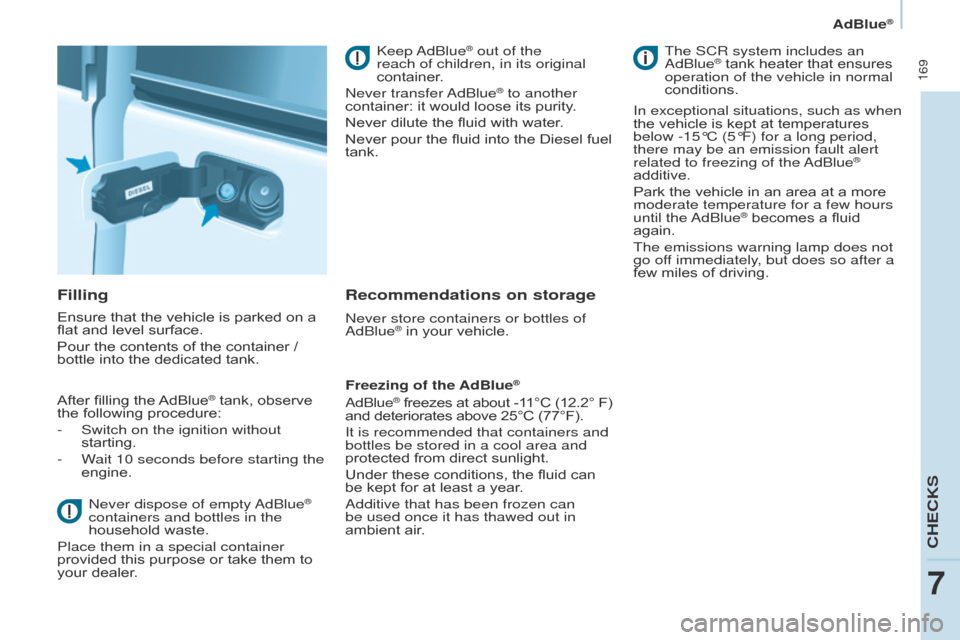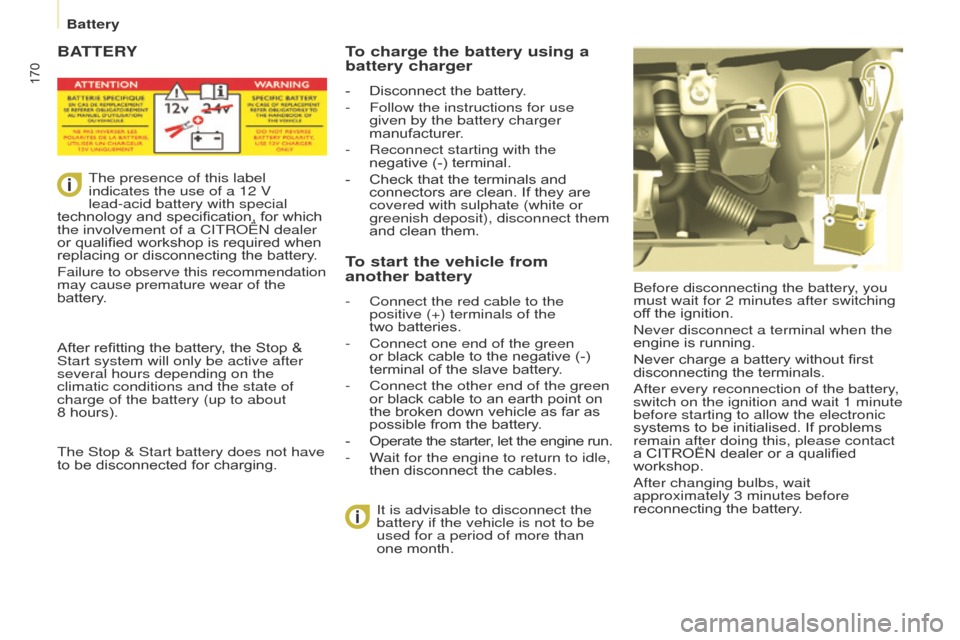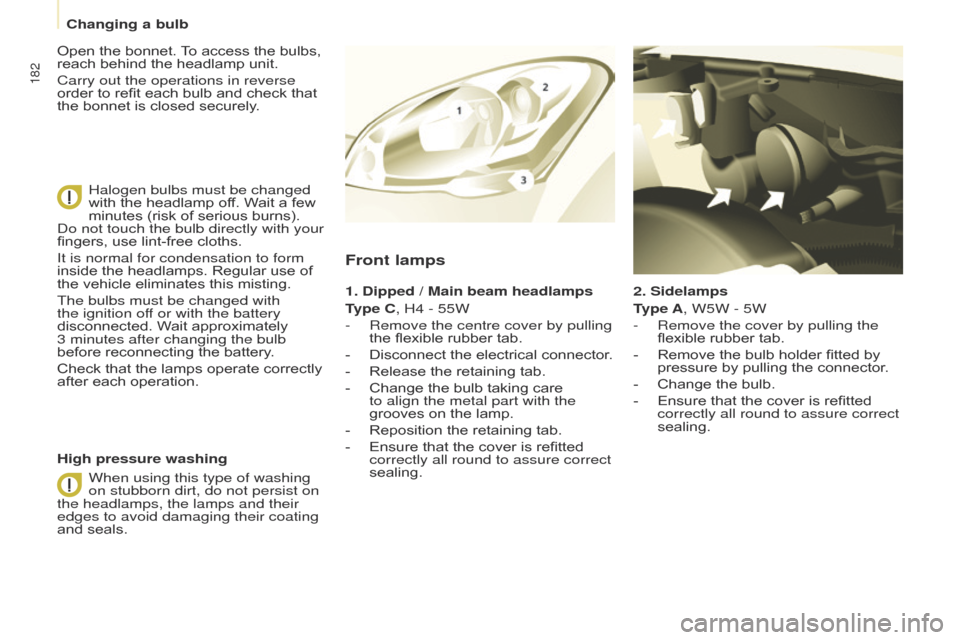ignition Citroen BERLINGO MULTISPACE RHD 2017 2.G Service Manual
[x] Cancel search | Manufacturer: CITROEN, Model Year: 2017, Model line: BERLINGO MULTISPACE RHD, Model: Citroen BERLINGO MULTISPACE RHD 2017 2.GPages: 292, PDF Size: 10.19 MB
Page 160 of 292

158
Berlingo2VP_en_Chap07_Verification_ed02-2016Berlingo2VP_en_Chap07_Verification_ed02-2016
Cooling system
Only use the fluid recommended by the manufacturer.
Otherwise,
you risk seriously damaging
your
engine.
When the engine is warm, the
temperature of the coolant is controlled
by
the engine fan.
As
this fan can
operate
with the ignition key removed
and because the cooling system is
pressurised, wait for at least one hour
after the engine has stopped before
carrying
out any work.
Slacken
the cap by 1/4 of a turn to
release the pressure to prevent any
risk
of scalding. When the pressure
has dropped, remove the cap and top
up
the level with coolant.
If
fluid has to be added frequently,
this indicates a fault which must be
checked
by a CITROËN dealer as
soon
as possible.
Power steering fluid level
The vehicle must be parked on level ground with the engine cold. Unscrew
the cap integrated with the gauge and
check
the level which must be between
the
MIN and MAX marks. In
order to regenerate the filter, you are advised to drive at a speed higher
than
40 mph (60 km/h) for at least five minutes as soon as possible, when
traffic
conditions permit (until the
message disappears and the service
warning
lamp goes off).
During regeneration of the particle
emission
filter, the noise of a relay
operating may be heard under the
dashboard.
If the message is still displayed and
if the service warning lamp remains
on, contact a CITROËN dealer or a
qualified
workshop.
Topping up
The level must be between the MIN
and
MAX
marks
on
the
expansion
bottle.
If
more
than
1
litre
of
fluid
is
required to top up the level, have the
system
checked
by
a
CITROËN
dealer
or
a
qualified
workshop.
Screenwash level
For best quality cleaning and for your
safety, we would advise that you use
products of the CITROËN range.
For optimum cleaning and to avoid
freezing,
this fluid must not be topped
up
or replaced with plain water.
Capacity
of the screenwash reservoir:
approximately
3 litres.
Diesel additive level
(Diesel with particle
filter)
Topping up
This additive must be topped up by
a CITROËN dealer or a qualified
workshop
without delay.
Waste products
Avoid prolonged contact of used oil
with the skin.
Brake
fluid is harmful to health and
very
corrosive.
Do
not dispose of used oil, brake fluid
or coolant into drains or into the ground
but into the containers dedicated to this
use at a CITROËN dealer (France) or
an
authorised waste disposal site.
The minimum level of this additive
is indicated by lighting of the service
warning lamp, accompanied by an
audible signal and a message in the
screen.
When this occurs with the engine
running it is due to the start of
saturation
of
the
particle
filter
(exceptionally prolonged urban type
driving
conditions:
low
speed,
long
traffic
jams,
...).
Levels
Page 165 of 292

163
Berlingo2VP_en_Chap07_Verification_ed02-2016Berlingo2VP_en_Chap07_Verification_ed02-2016
DIESEL PRIMING
PUMP
If you run out of fuel, it is necessary to
prime
the fuel circuit.
Other HDi engines
- Fill the fuel tank with at least five litres
of Diesel.
-
Squeeze and release the manual
priming pump, under the bonnet,
under
the protective cover.
-
Operate the starter until the engine
starts.
BlueHDi engine
- Fill the fuel tank with at least five litres
of Diesel.
-
Switch on the ignition (without
starting
the engine).
-
W
ait around 6 seconds and switch
off
the ignition.
-
Repeat
the operation 10 times.
-
Operate the starter to run the
engine.
FUEL CUT- OFF
In a serious collision, a mechanism
automatically prevents fuel from
reaching
the engine.
The
flashing of this warning
lamp is accompanied by a
message
in the screen.
Check
that there is no odour or
leakage
of fuel outside the vehicle and
re-establish
the fuel supply:
-
switch of
f the ignition
(STOP
position),
-
remove
the key,
-
put
the key back in the ignition,
-
switch
on the ignition and start.
CHECKS
7
AdBlue®
Page 168 of 292

166
Berlingo2VP_en_Chap07_Verification_ed02-2016Berlingo2VP_en_Chap07_Verification_ed02-2016
Range indicators
Rules on the display of alertsFor more information on the
displays and warning lamps, refer
to chapter 3, "Instruments and
controls"
section. Range greater than 1 500 miles
(2 400 km)
No
information displayed.
Once the 1 500 miles (2 400 km)
threshold is reached, the UREA
warning lamp comes on temporarily
and the remaining range message is
displayed.
The alert is repeated every 200 miles
(300
km) until the next threshold is
reached.
Every time the ignition is switched
on, the alert is given, together with an
audible
signal.
Remaining range less than
1
500 miles (2 400 km) and greater
than 350 miles (600 km)
Driving range
With
the touch screen tablet:
If the range is greater than 3 100 miles
(5
000 km), a range value is not given.
Press this button to display
the
information.
-
select the "Driving
assistance" menu,
-
select "Diagnostic",
-
select
CHECK.
Different levels of alert are triggered
according to the remaining driving
range threshold
You will be informed as each mileage
threshold is reached and the alerts will
change
from temporary to permanent.
-
The 1st is triggered at a remaining
driving range of 1 500 miles
(2
400
km).
-
The 2nd is triggered at a remaining
driving range of 350 miles
(600
km).
-
Up to 0 miles, at which point it will
be impossible to restart the engine
after
a
stop.
AdBlue®
Page 169 of 292

167
Berlingo2VP_en_Chap07_Verification_ed02-2016Berlingo2VP_en_Chap07_Verification_ed02-2016
Once the 350 miles (600 km) threshold is reached, the UREA warning lamp
flashes
and the Service warning lamp
comes on, accompanied by a message
on
the remaining driving range.
The alert is repeated every 30 seconds
with an update of the remaining driving
range
in steps of 30 miles (50 km)
travelled.
Every time the ignition is switched
on, the alert is given together with an
audible
signal.
At 0 miles the system installed in
the vehicle to meet the emissions
standard will prevent engine
starting. Your vehicle's exhaust emissions no
longer meet the "Euro 6" standard and
the
engine will not start.
To be able to restart the vehicle, you
must add at least 4 litres of AdBlue
®.
-
Pour
the
additive
into
the
tank
(by
the
filler
with
the
blue
cap).
-
Switch on the ignition without
starting.
-
W
ait 10 seconds before starting the
engine.
Remaining range less than 350 miles
(600 km) and more than 0 miles
Starting prevented, breakdown related
to a lack of AdBlue
®
in the special tank
The
0
fluid
level
has been reached.
Avoid waiting until the
remaining range is 0 miles!
The alert is repeated when driving until
the AdBlue
® tank has been topped-up with
sufficient additive.
Unless the additive in the special
additive
tank is topped-up, you risk
immobilisation
of the vehicle. Following
this, make a further fill to
the special additive tank, the
capacity of which is
17 litres.
Fault with the SCR system
The UREA, Service and diagnostic
warning lamps comes on.
Every time the ignition is switched on,
the
emissions fault is confirmed by an
audible
signal and a message.
If it is a temporary fault, the alert
disappears as soon as the exhaust
emissions return to the levels required
by
the standard.
Detection
On the other hand, if the warning
lamps are still on after 30 miles
(50 km) of driving, the fault is
confirmed.
An engine start prevention system
will be activated automatically after
650 miles
(1 100 km) travelled
following
this confirmation.
Go
to a CITROËN dealer or a qualified
workshop.
Or go to a CITROËN dealer or a
qualified
workshop.
CHECKS
7
AdBlue®
Page 171 of 292

169
Berlingo2VP_en_Chap07_Verification_ed02-2016Berlingo2VP_en_Chap07_Verification_ed02-2016
Filling
Ensure that the vehicle is parked on a flat and level surface.
Pour
the contents of the container /
bottle
into the dedicated tank.
After
filling the
AdBlue® tank, observe the
following
procedure:
-
Switch on the ignition without
starting.
-
W
ait 10 seconds before starting the
engine.
Never dispose of empty AdBlue
®
containers and bottles in the
household
waste.
Place them in a special container
provided
this
purpose
or
take
them
to
your
dealer. Keep AdBlue
® out of the
reach of children, in its original
container.
Never transfer AdBlue
® to another
container:
it
would
loose its purity.
Never
dilute
the
fluid
with water.
Never
pour
the
fluid
into the Diesel fuel
tank.
Recommendations on storage
Never store containers or bottles of
AdBlue® in your vehicle.
Freezing of the AdBlue
®
AdBlue® freezes at about -11°C (12.2° F) and
deteriorates above 25°C (77°F).
It is recommended that containers and
bottles be stored in a cool area and
protected
from direct sunlight.
Under
these conditions, the fluid can
be
kept
for at least a year.
Additive that has been frozen can
be used once it has thawed out in
ambient air. The SCR system includes an
AdBlue
® tank heater that ensures operation of the vehicle in normal
conditions.
In exceptional situations, such as when
the
vehicle
is kept at temperatures
below -15°C (5°F) for a long period,
there may be an emission fault alert
related to freezing of the
AdBlue
®
additive.
Park
the
vehicle
in
an
area
at
a
more
moderate temperature for a few hours
until
the AdBlue
® becomes a fluid again.
The emissions warning lamp does not
go of
f immediately, but does so after a
few
miles
of
driving.
CHECKS
7
AdBlue®
Page 172 of 292

170
Berlingo2VP_en_Chap08_Aide-rapide_ed02-2016
BATTERY
Before disconnecting the battery, you
must wait for 2 minutes after switching
off the ignition.
Never disconnect a terminal when the
engine
is running.
Never
charge a battery without first
disconnecting
the terminals.
After every reconnection of the battery,
switch on the ignition and wait 1 minute
before starting to allow the electronic
systems
to be initialised. If problems
remain after doing this, please contact
a
CITROËN dealer or a qualified
workshop.
After changing bulbs, wait
approximately 3 minutes before
reconnecting
the battery.
It is advisable to disconnect the
battery if the vehicle is not to be
used for a period of more than
one month.
To charge the battery using a
battery charger
- Disconnect the battery.
-
Follow the instructions for use
given by the battery charger
manufacturer
.
-
Reconnect starting with the
negative
(-) terminal.
-
Check
that the terminals and
connectors
are clean. If they are
covered with sulphate (white or
greenish deposit), disconnect them
and
clean them.
To start the vehicle from
another battery
- Connect the red cable to the
positive (+) terminals of the
two batteries.
-
Connect one end of the green
or
black cable to the negative (-)
terminal
of the slave battery.
-
Connect the other end of the green
or
black cable to an earth point on
the
broken down vehicle as far as
possible
from the battery.
-
Operate
the starter, let the engine run.
-
W
ait for the engine to return to idle,
then
disconnect the cables.
The presence of this label
indicates the use of a 12 V
lead-acid battery with special
technology
and
specification,
for
which
the involvement of a CITROËN dealer
or
qualified
workshop
is
required
when
replacing
or
disconnecting
the
battery.
Failure to observe this recommendation
may cause premature wear of the
battery.
After
refitting
the
battery,
the
Stop &
Start system will only be active after
several hours depending on the
climatic conditions and the state of
charge of the battery (up to about
8 hours).
The Stop & Start battery does not have
to
be
disconnected
for
charging.
Battery
Page 173 of 292

171
Berlingo2VP_en_Chap08_Aide-rapide_ed02-2016
ECONOMY MODE
After the engine has stopped, with
the
key in the ignition position, certain
functions (windscreen wiper
, electric
windows, courtesy lamps, audio
equipment,
etc.) can only be used for a
cumulative duration of thirty minutes, to
prevent
discharging of the battery.
Once the thirty minutes have elapsed,
the active functions are put on standby
and
the battery warning lamp flashes
accompanied by a message in the
screen.
T
o resume the use of these functions
immediately, start the engine and let it
run
for a few minutes.
The time available will then be double
the time for which the engine was left
running.
However, this time will always
be
between five and thirty minutes.
A
flat battery will prevent the
engine
from starting.
Battery
QUICK HELP
8
Page 175 of 292

173
Berlingo2VP_en_Chap08_Aide-rapide_ed02-2016Berlingo2VP_en_Chap08_Aide-rapide_ed02-2016
1. Parking the vehicle
- The occupants must get out of the
vehicle and wait in a safe location.
-
If
possible, park the vehicle on
level, stable and non-slippery
ground.
-
Apply
the parking brake, switch
of
f the ignition and engage first or
reverse
gear. -
Place
a chock under the wheel
diagonally opposite the one to be
changed.CHANGING A WHEEL
under the passenger footwell behind
the
driver's seat.
-
If necessary
, move the seat forward
to access the storage compartment
from
the rear.
-
Remove
the flap then take out the
jack
and the tool carrier.
-
Remove the tools needed from the
carrier
.
1.
Jack.
2.
Wheelbrace.
3.
Chock.
4.
Spanner for the Modutop roof bars
and
rear lamps.
5.
Alloy
wheel trim removal tool.
6.
T
owing eye.
If
the
vehicle
is
fitted
with
a
towbar,
it is sometimes necessary to raise
the
vehicle
slightly
to
make
it
easier
to remove the spare wheel from its
carrier
.
2. Tools
The tools are stowed in a storage area
closed by a flap under a front seat.
However, if the vehicle is not equipped
with a spare wheel, the towing eye is
located in the storage compartment On certain types of ground and/
or if considerable loads are being
transported, call a CITROËN dealer or
a qualified workshop.
The jack and tools are specific to your
vehicle.
Do not use them for other
purposes.
QUICK HELP
8
Changing a wheel
Page 184 of 292

182
Berlingo2VP_en_Chap08_Aide-rapide_ed02-2016Berlingo2VP_en_Chap08_Aide-rapide_ed02-2016
2. Sidelamps
Type A, W5W - 5W
-
Remove the cover by pullin
g the
flexible
rubber tab.
-
Remove
the bulb holder fitted by
pressure
by pulling the connector.
-
Change
the bulb.
-
Ensure
that the cover is refitted
correctly all round to assure correct
sealing.
Front lamps
1. Dipped / Main beam headlamps
T ype C, H4 - 55W
-
Remove the centre cover by pullin
g
the
flexible rubber tab.
-
Disconnect
the electrical connector.
-
Release
the retaining tab.
-
Change
the bulb taking care
to align the metal part with the
grooves
on the lamp.
-
Reposition
the retaining tab.
-
Ensure
that the cover is refitted
correctly all round to assure correct
sealing.
High pressure washing Open
the
bonnet.
T
o
access
the
bulbs,
reach
behind
the
headlamp
unit.
Carry out the operations in reverse
order
to
refit
each
bulb
and
check
that
the
bonnet
is
closed
securely.
Halogen bulbs must be changed
with
the
headlamp
off.
Wait
a
few
minutes
(risk
of
serious
burns).
Do not touch the bulb directly with your
fingers,
use
lint-free
cloths.
It is normal for condensation to form
inside
the
headlamps.
Regular
use
of
the
vehicle
eliminates
this
misting.
The bulbs must be changed with
the ignition off or with the battery
disconnected.
Wait
approximately
3
minutes after changing the bulb
before
reconnecting
the
battery.
Check
that
the
lamps
operate
correctly
after
each
operation.
When using this type of washing
on stubborn dirt, do not persist on
the headlamps, the lamps and their
edges to avoid damaging their coating
and
seals.
Changing a bulb
Page 190 of 292

188
Berlingo2VP_en_Chap08_Aide-rapide_ed02-2016Berlingo2VP_en_Chap08_Aide-rapide_ed02-2016
Dashboard fuses
Tilt the cover to gain access to the
fuses.Fuses
F Amperes
A Allocation
1 15 Rear wiper
2 - Not used
3 5 Airbag
4 10 Air
conditioning, diagnostic socket, mirror control,
headlamp beam
5 30 Electric windows
6 30 Locks
7 5Rear courtesy lamp, front map reading lamp, roof
console
8 20 Audio
equipment, screen, tyre under-inflation
detection, alarm and siren
9 30 Front
and rear 12V socket
10 15 Central column 11 15 Low current ignition switch
12 15 Rain and sunshine sensor, airbag
13 5 Instrument panel
14 15 Parking
sensors, digital air conditioning controls,
hands-free
phone kit
15 30 Locks
16 - Not used
17 40Rear
screen/mirrors demist/defrost
Changing a fuse